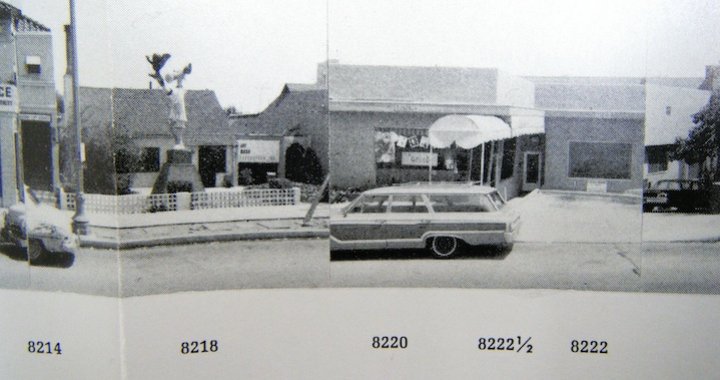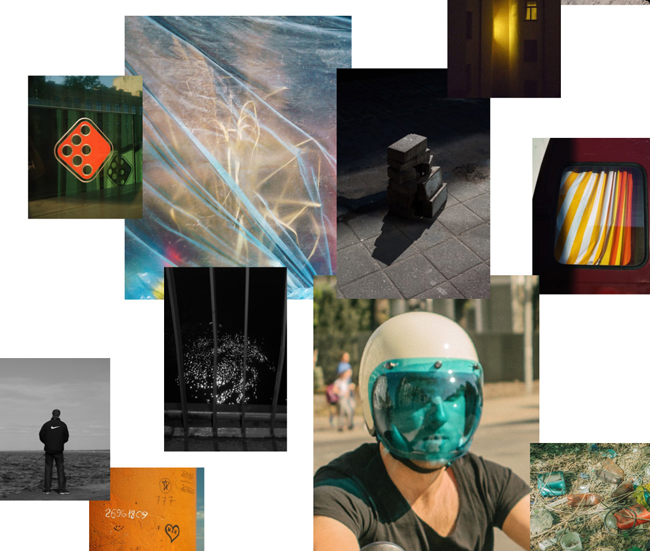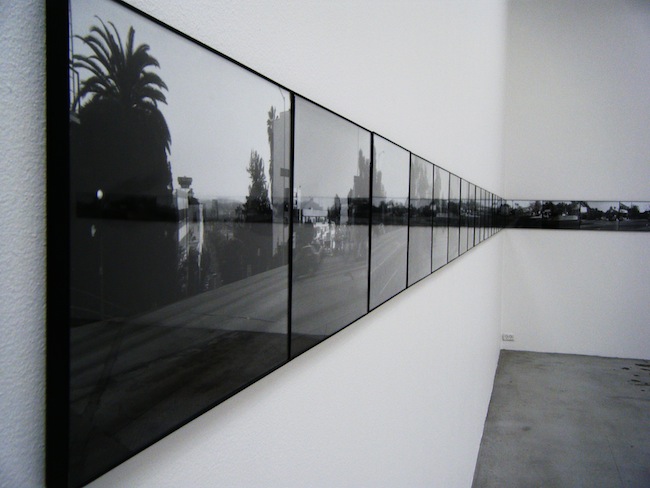
Every Building On The Sunset Strip, None of The Buildings On Sunset Strip
Jacob Stubbe Østergaard
06/06/2013
Every Building On The Sunset Strip / None of The Buildings On Sunset Strip
Ed Ruscha and Jonathan Monk
Galleri Nicolai Wallner, Copenhagen
May 24 – June 22, 2013
After spending half an hour with the exhibited works by Ed Ruscha and Jonathan Monk, I find myself more interested in the grey, concrete floor of the exhibition hall. I examine its humps and cracks and the small variations in its grey colour. Why am I doing this? Because the exhibition is that boring? Not at all. Actually it's because the exhibition was interesting. Allow me to explain...
There are two works of art in the big, white exhibition hall.
The first is Every Building On The Sunset Strip – a well-known piece of conceptual art made by American artist Ed Ruscha in 1966. It measures no less than 27 feet in length and just normal page size in height. It's a fold-out print of the famous Sunset Strip in Los Angeles, in its entirety. A series of black-and-white photos, taken by a camera mounted on top of a car, have been pieced together to form one continuous view of the street. One side of the Strip is on the top of the page, and the other is upside down at the bottom.
Ed Ruscha. Every Building On The Sunset strip. 1966. Courtesy of Galleri Nicolai Wallner
The other work is called None of The Buildings On Sunset Strip, by British artist Jonathan Monk, made when he was living in Los Angeles in 1998. It consists of a horizontal series of framed black-and-white photographs each casting a view down one of the side streets of the Sunset Strip.
These two works of art, exhibited together for the first time, are crammed into each their end of the hall, with a big empty space between them. In this way, they quite resemble a parent and a teenager sulking in different ends of the apartment after a fight, acting normal in silence and demonstratively ignoring the other. So, what were they fighting about? What concepts and what ideas do they represent? And do they actually love each other, when they're not fighting? I'll ask the parent artwork first.
First, I find out its background in the (subsequently termed) 'Pop Art' environment in Los Angeles.

Jonathan Monk. None of The Buildings On Sunset Street. 1998 (1 of 34 pictures). Photo: Anders Sune Berg
Pop Art: Ordinary is interesting!
One day in 1956, Ed Ruscha got in a car and left his hometown in Oklahoma to go study graphic design in the mythical city of dreams on the sun-bathed west coast. In Los Angeles, he learned advertising, design and photography. These would become important tools for an artist in the era of Pop Art, where a culture defined by mass production and television uniformity caused art to take an interest in what had hitherto been perceived as trivial and 'everyday'. Advertisements, brands, celebrities and functional items such as cars, houses and refrigerators became cherished motifs for this generation of visual artists. One important strategy was 'defamiliarization': placing very common objects in unusual contexts, exaggerating them or altering them to produce an uncanny effect. Pop Art thus dug below the myths governing the apparently superficial culture of the time. Andy Warhol famously exhibited 25 Marilyn Monroe faces in a grid. Ed Ruscha, instead, exhibited 26 Gasoline Stations in 1962 – the precursor to Every Building On The Sunset Strip. 26 Gasoline Stations was simply a book of photographs of every gas station between Los Angeles and Ruscha's Oklahoma hometown, subtitled with the name of the gas station and its location. Ruscha insistently denied that this was art. “it is not a book to house a collection of art photographs – they are technical data like industrial photography. To me, they are nothing more than snapshots”, he said. With Every Building..., he took the idea of producing documentations rather than artworks one step further. 26 Gasoline Stations was based on a special interest in gas stations, but Every building... seems to be interested in everything. At least at first glance, nothing seems to be missing from the Sunset Strip.
“Trying to look at the whole picture...”
Back in the exhibition hall, I have already cast my first, second and third glances at Ruscha's Strip. My instinct immediately tells me to think of it as conceptual art. I'm less interested in the actual images (after all, it's just a street...) than in the idea that brought them about. 'Is it really a 'pure' documentation?', I wonder. And does it say something about the way we view streets and cities in general? I begin to think it's trying to experiment with the way we see – the movements of the eye when we see something and subconsciously classify some areas of our vision as objects and filter out other areas as noise. Then I chastise myself for not taking the actual imagery into account. Maybe the work says something about Los Angeles and thereby the culture of the time and place. The facades are full of shop names that might change next year. The shop names are a collection of facts whose importance or unimportance may be reconsidered now that they are exhibited in the realm of art. This is the logic of the readymade, first employed by Marcel Duchamp in his (in)famous exhibition of a urinal.
Ruscha has talked about “Every building...” both in terms of its content and its concept, at one occasion commenting: “Los Angeles to me is like a series of store-front planes that are all vertical from the street, and there's almost like nothing behind the facades”, and at another occasion expanding on the concept: “I'm as interested in some of the less obvious things... People look at the buildings and say, 'What was that building before?' Well, what about the sidewalk in front of it, and the curb that surrounds it, and embankments here and there? I'm trying to look at the whole picture.”
So I'm a little bit split between the image and the concept. Then I remember the other artwork, hanging behind me. None of The Buildings... definitely wants to talk about documentation and selection.
None... bears the same last part of the name as Every.... It's a kind of parasite on the older work, making dramatically more sense when viewed in its context. Where Every ...attempted a comprehensive view of the Strip, challenging the eye not only to notice the catchy spots like big letters or weirdly shaped buildings, None... has simply removed all the natural points of focus and left only the apparently less interesting parts of the Strip. The eye is of course unimpressed by this. When I turn my two eyes towards None..., they immediately begin looking for points of interest. They stop at cars, trees and roadsigns. Because the pictures in None... are taken at the interjections, most of them display a “Sunset Blvd” roadsign. Every... includes many different words on the facades, but “Sunset Blvd”, repeated many times, are the only words in None.... In this way, None...challenges the identity of the street as such. Jonathan Monk has removed every building from Every Building On The Sunset Strip, and what does he have left? The Sunset Strip, of course. The numerous “Sunset Blvd” signs stress the claim that this is the actual street. Then, of course, we get into all kinds of philosophical trouble: If the street is actually just the asphalt and the trees and the air, is there even any difference between streets, apart from their names? And what's in a name anyway? Does the name “Sunset Blvd” spread the mythology of the street's famous nightlife (which takes place in buildings) out even to the bushes and the trees and the empty interjections showed in Monk's work? Maybe he wanted to criticize the title of Every Building... for giving special treatment to buildings at the cost of other parts of the street, and thereby failing, after all, to achieve the neutrality it strives after. But of course None of the buildings... also fails at this, having omitted the buildings and set a particular focus based on the context of Every Building....
Jonathan Monk. None of The Buildings On Sunset Street. 1998. Courtesy of Galleri Nicolai Wallner
The infra-ordinary is extra-interesting
None... carries on where Every... left off – searching for a pure, neutral perspective. Their quarrels with each other seem more like the quarrels of scientists now than parent and child. They criticize each other with the common goal of achieving greater understanding. These two works stand together in the quest to find out exactly how we are pre-programmed only to notice certain things and to ignore others. This is a quest for individual freedom. I realize now that Ruscha and Monk's exhibition, which I am standing in right now, is part of the strange and little-known, but highly interesting history of the phenomenon of the “infraordinary”. Infraordinary is the opposite of extraordinary: That which is invisible because we filter it out as un-interesting before we even notice it. This intriguing history begins in Paris...
Paris, 1831: newspapers first write about the flaneur – the strange city figure who walks in the streets at a slow pace, refusing to follow the fast and commodity-focused logic of the shopping arcades, observing other people rather than acting, noticing what is otherwise unnoticed. The flaneur is later made famous by Charles Baudelaire and Walter Benjamin.
Sussex, 1937: a group of British surrealists establish Mass Observation. They conduct random surveys, asking a large number of completely ordinary people a number of varied questions. They also ask people to submit diary entries to their database. This is an attempt to work around our normal preconceptions about what's intersting and what's not. Such preconceptions can be used as tools of power, which is why Mass Observation, seeking to deconstruct them, was regarded as a political project.
London, 2002: Derren Brown, famous magician and illusionist, talks about his incredible card tricks: “The people at the table, the ones looking right at you and trying to uncover the trick...”, he says – “...those are the easiest to control. A magician is more worried about those standing in the bar, watching only with half an eye or turning to look suddenly at random times. You never know what they might notice.”. So, the indiscriminate glance that Ruscha and Monk are exploring can be used to see the puppeteer's strings.

The original, Parisian flaneur. Noticing the unnoticed since 1831
The world, now – : “infraordinary” has become a viable academic term. It is especially relevant in urban design – a field which has been badly ridden by ideas of total vision. Modernist city planners tried to develop a formula for city living, based on a list of the functions of the city: dwelling space, recreational space, working, eating, shopping, transportation... Inevitably, when such masterplans were made into cities on the drawing board, all of the unforeseen requirements of a space for human inhabitation had been fatally neglected. In 1984, French sociologist Michel de Certeau wrote the famous essay, “Walking In The City”, which gave birth to the idea that a city consists most importantly of things we cannot see and hardly even speak of: spatial relations guiding our movement patterns along with memories and neuroses, blind knowledge of relations between different places in the city, collectively intertwining walking practices and subjective mappings of “home” and “away”. The bird's eye drawing-board view, focusing on objects (buildings), misses all of this.
Through their pictures of a notorious city space, Ruscha & Monk explore our perceptive processes in exactly this context.
Every Building... is an attempt to present an unbiased, human-eye view of a street. But it fails because it is manipulated and drawn out and, still, only a static picture of the city, which I, the viewer, still standing in the exhibition hall, view at a distance and from above.
None of The Buildings... continues the quest by removing all the focus points and stressing the inbetween spaces. But in order to free the eye from the seductive shop signs and facades, it sacrifices continuity and becomes representative of another selective interest. The buildings are perhaps even more present in None of The Buildings..., because their placement has determined the exact space of this work. Our eyes are still being led.
And that's it! I finally understand why the works are placed in a big, blank exhibition hall, seemingly too spacious for these two works. It's a challenge to my own pre-conceptions about what's interesting to look at. Will I allow my view to be controlled by the positioning of the works, to focus only on the two extraordinary objects in the room? No. Before I go out into the sunshine where my friend is waiting for me, I take a closer look at the concrete floor. I notice its unevenness, its cracks and the patterns of its various shades of grey. And on the way out, I notice exactly how the custodian sits on her chair and the mold on the planks of the fence separating the gallery from the street.
The floor of Galleri Nicolai Wallner. Courtesy of Galleri Nicolai Wallner


